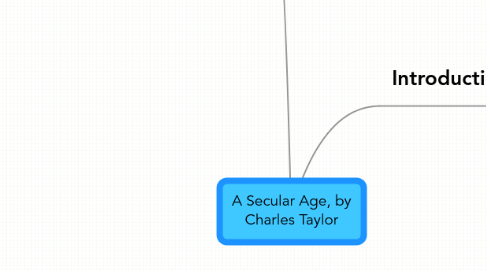
1. Part 1: The Work of Reform
1.1. Chapter 1: The Bulwarks of Belief - Why was it impossible not to believe in God in 1500, but easy in 2000?
1.1.1. 1.1 disappearance of certain features of the world facilitated shift in source of fullness
1.1.1.1. the three features of the world that made God seemingly undeniable in 1500
1.1.1.1.1. what were the features?
1.1.1.1.2. what made the features disappear?
1.1.1.2. further conditions making a shift in source of fullness (exclusive humanism) imaginable in the absence of those features
1.1.1.2.1. invention of a "buffered" self, invulnerable to spirits and powers, was made possible by
1.1.1.2.2. confidence in our own powers of moral ordering, capacity to shape natural and social world (unlike Epicureanism)
1.1.1.2.3. a substitute for agape, a drive toward human beneficience (unlike Epicureanism)
1.1.2. 1.2 why a diachronic account is necessary
1.1.2.1. our understanding of ourselves in this secular age is inescapably backward-looking, felt to be a triumph
1.1.2.2. "subtraction" accounts recognize importance of history, but get it wrong; these need correcting
1.1.3. 1.3 - 1.5 Five changes in naive understanding
1.1.3.1. (I) disenchantment
1.1.3.1.1. formerly we were "porous", now we are "buffered"
1.1.3.1.2. nowadays the world outside of human action is seen as regulated by exceptionless law
1.1.3.2. (II) God had an existential-foundational role in society, which was itself seen as a locus of spiritual power
1.1.3.2.1. the "buffered self" understanding lends itself to individuality and may not be hospitable to a sense of community; we moderns can disengage from our social environment.
1.1.3.2.2. the common weal was bound up in collective rites (beating the bounds, eg [see video]), devotions, allegiances; breaking ranks posed a menace to everyone.
1.1.3.2.3. the indispensable reality of society argued for the existence of God in the enchanted world: parishes protected by collective rites, thaumaturgical powers inherent in the king, and the like
1.1.3.3. (III) play of structure and anti-structure held in equilibrium
1.1.3.3.1. examples from former times
1.1.3.3.2. explanation
1.1.3.4. (IV) the social was grounded in sacred and secular time in higher times
1.1.3.4.1. earlier conceptions of time
1.1.3.4.2. modern conceptions of time
1.1.3.5. (V) cosmos replaced by neutral universe
1.1.3.5.1. cosmos
1.1.3.5.2. universe
1.1.4. 1.6 Reform: after Dark Age in Latin Christendom a "rage for order" wants to deligitimate less dedicated forms of worship
1.1.4.1. two speeds of life
1.1.4.1.1. lay life
1.1.4.1.2. renunciative vocations
1.1.4.2. two-speed system stable for some
1.1.4.2.1. marginal populations who saw religion in terms of categories of sacred power and miracle-making they were already familiar with
1.1.4.2.2. correct, canonical meaning left to the clerical missionaries
1.1.4.3. gap narrows after 1000
1.1.4.3.1. growth of popular Christocentric spirituality focussed on suffering humanity of Jesus
1.1.4.3.2. not much left of paganism, but practices still different for certain elites
1.1.4.4. the climacteric in early 1500
1.1.4.4.1. attack from above
1.1.4.4.2. attack from below
2. Introduction
2.1. 0.1 what does secularism mean?(Three types of secularism)
2.1.1. secularism 1
2.1.1.1. defintion: public political/social activities emptied of god
2.1.1.2. problem: not really what concerns people; consider India as counterexample.
2.1.2. secularism 2
2.1.2.1. definition: decline of belief and practice
2.1.2.2. problem as account of secularization: "science refutes religion, crowds out belief" not a plausible story.
2.1.3. secularism 3
2.1.3.1. definition: belief in god is felt and understood to be one option among others, and not an easy one, an embattled one.
2.1.3.2. This is where we find a deeper account of secularization
2.2. 0.2 explaining the coming of a secular age (secularism 3)
2.2.1. consider experience, what it's like to live as a believer and an unbeliever (three modes of our moral/spiritual life)
2.2.1.1. mode 1: orientation toward a place of fullness
2.2.1.1.1. believer (without)
2.2.1.1.2. unbeliever (within) [3 types]
2.2.1.2. mode 2: emptiness, experience of exile
2.2.1.3. mode 3: stabilized middle condition, escaped from emptiness without having reached fullness
2.2.2. consider disruptive shift in the background of belief/unbelief, in the context in which we experience and search for fullness
2.2.2.1. away from a "naive" framework w/ theistic construal
2.2.2.1.1. definition: one construal is lived as immediate reality, like stones and rivers; there was variability only in distance from the singular place of fullness, fuller and lesser devotion, not a choice between alternative construals.
2.2.2.1.2. examples
2.2.2.2. toward a "reflective" framework, trending toward unbelief as default option
2.2.2.2.1. definition: almost no one is capable of naively living in one construal as simple reality, unaware of alternatives
2.2.2.2.2. navigating two standpoints
2.2.2.2.3. differences across milieux, but presumption of unbelief has achieved hegemony in academic and intellectual life, and is spreading from there
2.3. 0.3 defining religion in our culture as recognition of the transcendent, serving a good beyond human flourishing
2.3.1. examples
2.3.1.1. Judeo-Christian religious tradition worships God as the ultimate end, human flourishing is incidental
2.3.1.2. the Buddha explains how to attain bliss, but it involves a radical change in identity, a renunciation of recognizable human flourishing
2.3.2. exceptional religions/philosophies
2.3.2.1. Taoism conceives of reverence as essential to our flourishing, a proper part of the human good.
2.3.2.2. Platonism and Stoicism
2.3.2.3. Epicureanism (actually an early self-sufficing humanism, but only among an elite minority)
2.3.3. contrast with modern self-sufficing or exclusive humanism
2.3.3.1. not the only alternative to religion
2.3.3.1.1. anti-humanisms: Nietzsche, deconstruction, etc
2.3.3.1.2. non-exclusive humanism: deep ecology
2.3.3.2. crept up on us via Providential Deism
2.3.3.3. made conceivable for the masses a life without any goals beyond human flourishing
2.3.4. three dimensions of transcendence
2.3.4.1. the sense that there is some good higher than, beyond human flourishing
2.3.4.2. the context of belief in a higher power, the transcendent God of faith
2.3.4.3. seeing lift as going beyond the bounds of birth and death
2.4. 0.4 it is not easy to explain why secularism came about
2.4.1. "subtraction stories" explaining secularity in terms of sloughing off or liberating ourselves from illusions are too easy
2.4.2. secularity is the fruit of new inventions, new constructed self-understandings and related practices
